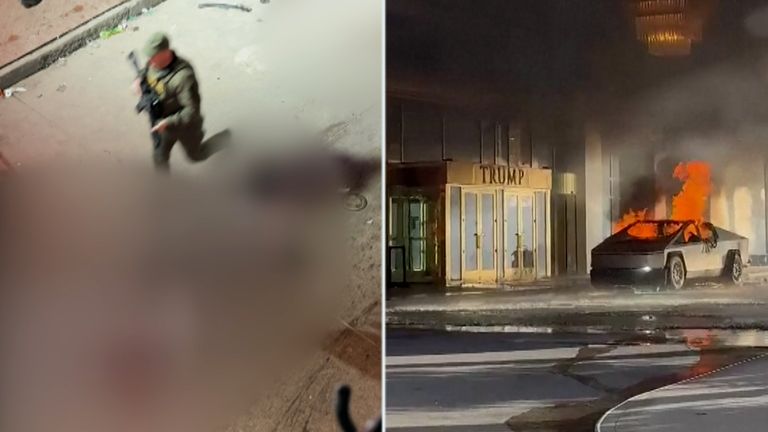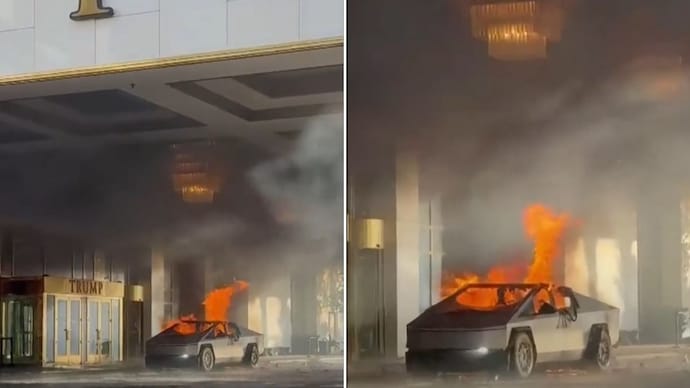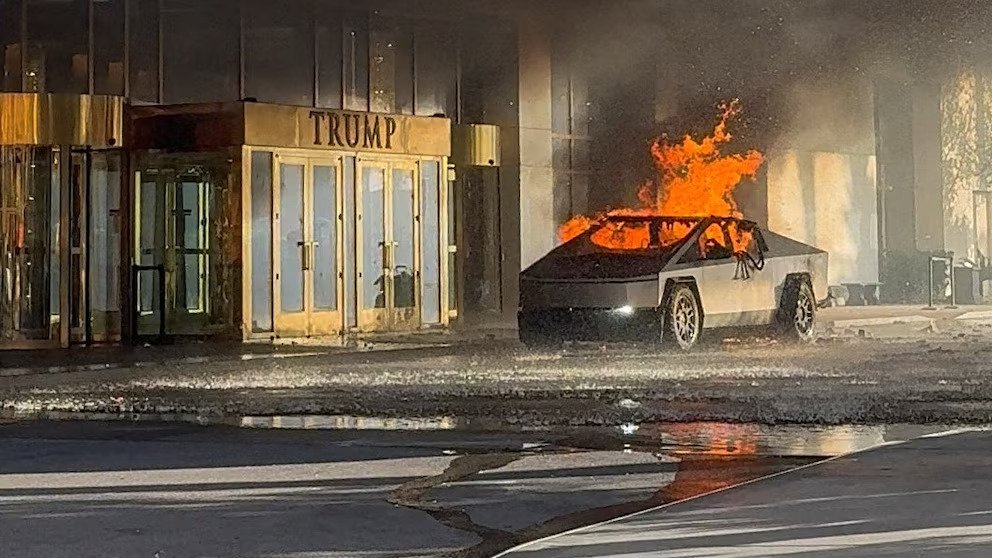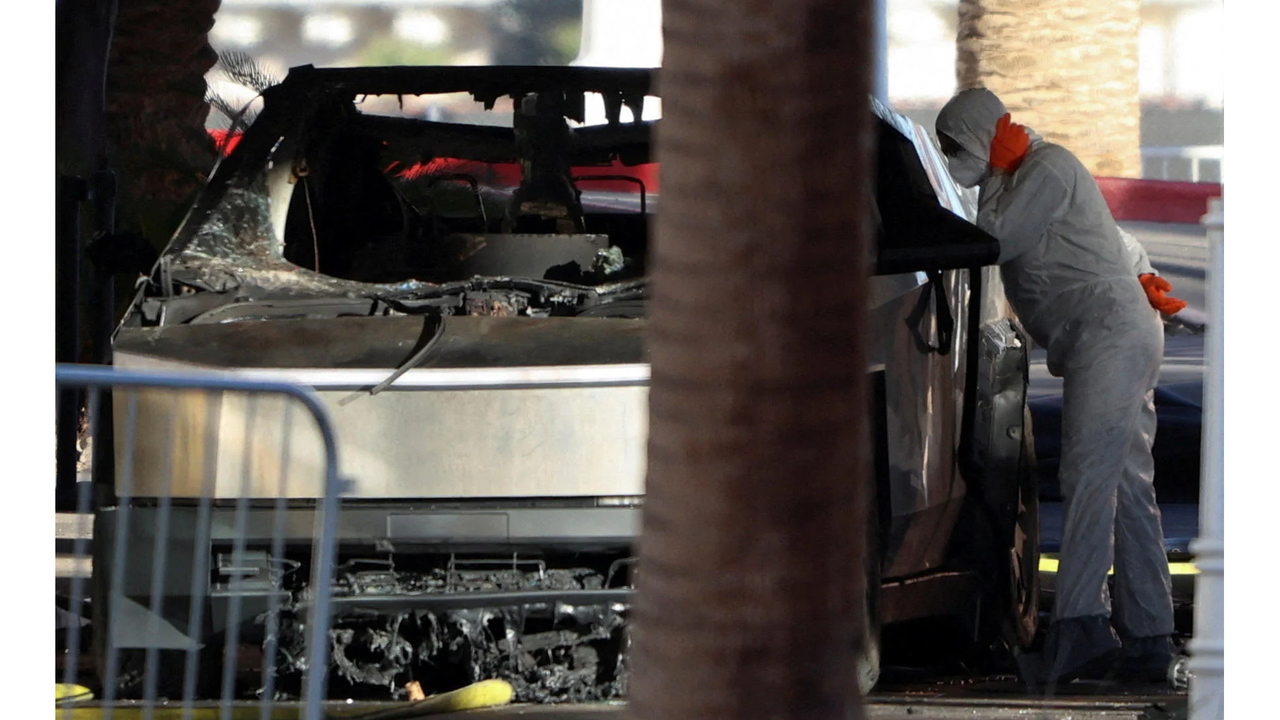On January 1, 2025, Tesla Cybertruck explosion happened just outside the Trump International Hotel in Las Vegas, Nevada. The explosion led to the tragic death of the driver, identified as 37-year-old Matthew Livelsberger, an active-duty member of the U.S. Army. In addition to the fatality, seven other individuals were injured in the explosion. Local authorities, alongside federal agencies, have launched a thorough investigation into the cause of the explosion and whether it could be linked to other similar incidents.
In this article, we will explore the sequence of events, the aftermath, the ongoing investigation, and the implications for vehicle safety and public security.
Details of the Tesla Cybertruck explosion
What Happened?
Around 8:40 a.m. on January 1, 2025, the Tesla Cybertruck was seen arriving at the front entrance of the Trump International Hotel. Witnesses reported that the vehicle was stationary for a brief moment before a massive explosion occurred. The explosion created a massive fireball, quickly engulfing the vehicle in flames. The fire spread to nearby structures, causing extensive damage to the hotel lobby and the surrounding area.
First responders were on the scene within minutes, working to control the flames and secure the area. Thankfully, the fire was extinguished swiftly, preventing a more significant disaster. However, the damage was enough to cause concern about the safety of electric vehicles, especially the Tesla Cybertruck, which is known for its advanced design and battery technology.
Casualties and Injuries
The driver of the Cybertruck, Matthew Livelsberger, was killed in the explosion. His body was found inside the vehicle, severely burned by the fire. Authorities confirmed that he had rented the Cybertruck from a vehicle-sharing app and had traveled from Colorado Springs, Colorado, to Las Vegas the day before the incident.
Seven others were injured in the explosion, including hotel staff, bystanders, and tourists. These individuals suffered injuries ranging from burns to cuts caused by flying debris from the explosion. All the injured were immediately taken to a nearby hospital for treatment. Thankfully, no life-threatening injuries were reported, and all individuals were later discharged after receiving medical attention.
The Investigation
Identifying the Driver
Matthew Livelsberger’s identity was confirmed through personal documents found at the scene of the explosion. He was an active-duty member of the U.S. Army, stationed in Colorado Springs, Colorado. It was later revealed that Livelsberger had rented the Cybertruck from the Turo app, a popular vehicle-sharing service, and drove the truck from Colorado to Las Vegas the previous day.
The fact that the vehicle was rented through a third-party service has raised questions about whether the truck had been tampered with or if Livelsberger had made any modifications to the vehicle that could have led to the explosion. Investigators are reviewing the history of the truck’s rental and any potential changes that could have been made to its components.
Exploring Possible Terrorist Links
One of the primary lines of investigation centers on whether this incident could be an act of terrorism. The timing of the explosion, occurring on the same day as a similar incident in New Orleans, has led authorities to consider the possibility of coordinated attacks. In both cases, the individuals involved rented vehicles, and there are suggestions that the drivers may have military backgrounds.
Authorities are working to determine if Livelsberger’s military service played a role in the explosion or if he was involved in a larger plan. Security footage from the hotel, as well as data from the vehicle’s onboard systems, is being analyzed for clues that may indicate whether the explosion was deliberate.
Investigating Vehicle Modifications
The cause of the explosion is still unclear. Investigators are looking into whether modifications to the Cybertruck played a role. The Cybertruck uses advanced battery technology. Tesla has made efforts to ensure safety, but questions about lithium-ion battery safety in high-impact situations have arisen.
Investigators are also exploring external factors, like extreme weather or road hazards. These could have caused a malfunction in the vehicle’s battery system. The explosion has raised concerns about the safety protocols for electric vehicles, especially those with unique designs like the Cybertruck.
Tesla’s Response

Elon Musk’s Statement
Elon Musk, CEO of Tesla, expressed his shock at the explosion through social media. Stating, “We’ve never seen anything like this before. Our deepest condolences go to the family of the driver and those affected by the event”. Musk emphasized that Tesla’s engineers were already reviewing the incident and promised full cooperation with the authorities to get to the bottom of the situation.
Musk’s statement has not only drawn attention to the explosion itself. But also to the broader conversation about the safety of Tesla’s electric vehicles. Tesla’s high-tech features such as the Tesla Emblem, its reinforced exoskeleton and advanced battery systems, have been lauded for their innovation. However, with this incident, doubts have emerged about whether these vehicles are fully prepared for the risks of high-speed accidents, fires, and explosions.
Tesla’s Safety Features
Tesla’s vehicles are designed with several safety features, such as thermal management systems for batteries, which aim to prevent overheating and explosions. The company has a rigorous testing process in place to ensure the safety of its cars. However, incidents like this raise important questions about whether the current safety measures are sufficient to prevent catastrophic failures in extreme circumstances.
The explosion outside the Trump International Hotel may serve as a catalyst for revising safety standards for electric vehicles. Tesla is expected to conduct an internal investigation into the failure of its vehicle’s safety features, especially concerning battery systems.
The Reaction from the Las Vegas Community

Public Fear and Speculation
The explosion has left the Las Vegas community in a state of shock and fear. Tourists and residents near the Trump International Hotel are worried about the safety of electric vehicles. They fear these vehicles could cause harm in public spaces.
Speculation about the explosion is widespread. Some believe it may be linked to terrorism. Others think it could have been an accident due to a malfunction or vehicle defect. The Trump International Hotel, a well-known landmark, is now in the spotlight. The explosion near such a high-profile property has raised concerns. People are asking what went wrong and if similar events could occur again.
Hotel’s Statement
The Trump International Hotel released a statement following the explosion. The statement expressed condolences for the loss of life and said the hotel was working closely with authorities to aid in the investigation. The hotel confirmed that it was cooperating fully with law enforcement and assured guests that their safety remained a top priority.
The explosion has also raised questions about the security measures in place at the hotel. Given the high-profile nature of the property, it is expected that the hotel will review its security protocols to ensure the safety of its guests in the future.
The Bigger Picture: Vehicle Safety and Security

Implications for Electric Vehicles
The explosion of the Tesla Cybertruck has once again brought the issue of vehicle safety to the forefront. Electric vehicles, particularly those equipped with large battery systems. And have faced scrutiny in recent years due to their potential to catch fire or explode in certain conditions. While many safety experts maintain that electric vehicles are just as safe. If not safer, than traditional gas-powered cars, incidents like this highlight the need for more comprehensive safety protocols.
This explosion may prompt regulators and manufacturers to revisit safety standards for electric vehicles. With a particular focus on their battery systems. With the increasing popularity of electric vehicles. It is crucial to ensure that these cars are equipped with robust safety mechanisms to prevent disasters like this one.
Concerns About Public Security
The possibility that the explosion could be linked to terrorism has also raised concerns about the security of public spaces. Hotels, malls, and other popular locations could be seen as potential targets for such attacks. Authorities are already reviewing security measures in public areas and considering whether more needs to be done to protect citizens and prevent future incidents.
Conclusion
The Cybertruck explosion outside the Trump International Hotel has left a lasting impact on the community and the wider public. With one life lost, several injured, and many questions left unanswered. Authorities are working tirelessly to determine the cause of the explosion and whether it was an isolated incident or part of a larger plan.
The ongoing investigation into the explosion is focused on several key areas, including the vehicle’s safety features, any potential links to terrorism. Whether the explosion was caused by a technical failure or deliberate action. The outcome of this investigation could have lasting effects on vehicle safety standards and security measures in public spaces.
As Tesla, law enforcement, and other authorities continue to investigate the events surrounding the explosion. The broader public will be closely watching for answers and improvements in the way electric vehicles are regulated and protected.









